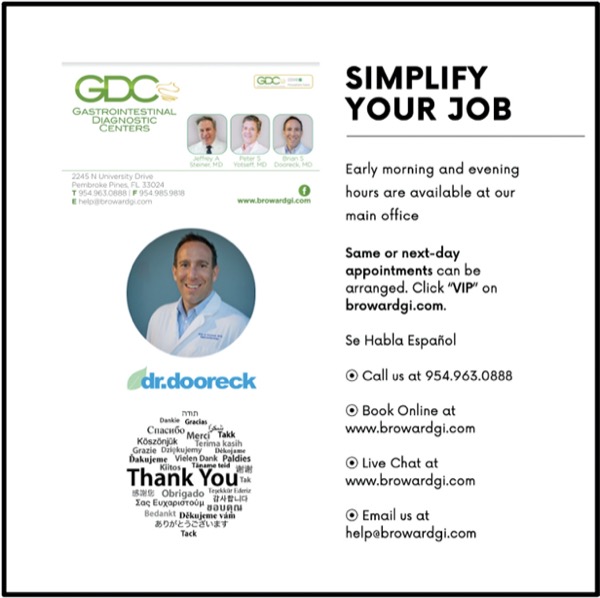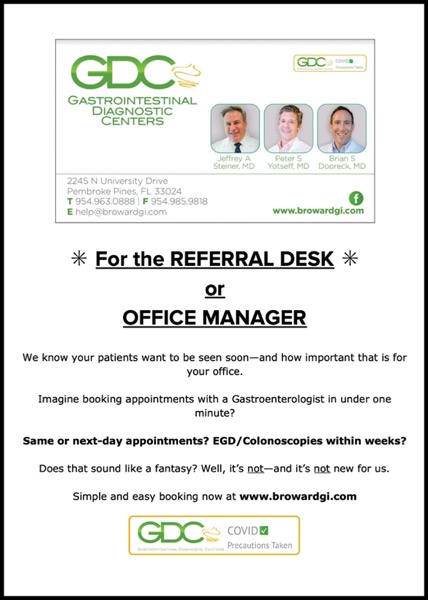
In the first part of this series of columns on how to grow your practice, we looked at some hard facts that drive patients and revenue to or away from you. We addressed how real these new online variables are now and how they have become the face of health care in my community and yours. We looked at building your online digital presence. We discussed reviews and why they matter—now more than ever.
For the second part, we dove into Google My Business and why your Google My Business page matters so much. We examined why the consistency of your information across all of the numerous reviews and other sites matters to Google to validate your business, and how to build that page to best present your business in today’s online world.
For this part, let’s go back to the basics: referrals. Yes, basic primary care referrals. We all know that referrals drive a lot of business and will remain the mainstay for many physicians and subspecialty practices, like gastroenterologists. That’s true for my practice and is likely the same for yours.
We also know reviews drive many new patients to doctors these days. We know that they cannot be ignored and must be embraced if you want to be active in the patient—read, consumer—marketplace. They are essential if you want to be ahead of the local market. They don’t matter if you do not want to grow your practice. I choose the first option.
But referrals matter, too. They matter a lot. The reality is that both referrals and reviews work hand-in-hand. They support each other and can also break each other. As the first column discussed:
- 75% of respondents are influenced by online rating and review sites when selecting a provider.1
- 91% of patients will choose one doctor over another based on positive reviews.2
- 60% of consumers check the ratings and reviews of a provider, even when referred by another provider, which is up 44% since 2018.
So, even if you have the strongest of referral patterns and consistent referrals from a primary care provider, these can be eroded by bad online reviews or unmonitored reviews without your response. Maybe you choose to ignore them or you simply don’t know they exist. Either way, you must be aware that you have an online digital presence in 2021—like it or not. It is your choice how you handle it. I know how I am choosing to handle mine.
Patients will Google you even if the referral order is telling them to see you. So, ask yourself: How many good reviews do you need to bury that one bad one, even if you feel it was not justified? How many would you want to see if you were searching online for a physician?
Here is my learned methodology of building a good referral network, a strategy that will support your good reviews and help minimize the negative ones. You have to truly care, provide excellence in services, and communicate with the patients and the referring provider. Remember that all of this—all of what we do—is a conversation. If you forget that, then you are losing ground in your practice growth every day, not to mention other areas of your professional fulfillment, at least in my opinion.
How did I grow my referral base? My secret, learned years ago, was not to focus solely on the doctor, the primary care provider or the provider. I targeted the true source of referrals: the referral desk, the office manager, the staff, the medical assistants or anyone who engages with the patient during their primary care encounters. That has been the highest yield by far.
It takes work. Calling, visiting, calling, emailing, faxing, calling. How many doctors actually call the referral coordinators or referral desk to introduce themselves? How many ask, “How are you doing?” or “What can we do to make the process easier for you and your patients?” Remember, most people want things to be easy. Is there any way you can make your process easier for the referral desk or a referring provider? One idea is to create fax forms and systems for them.
Can you think of a way to make the referral coordinator feel special? Try remembering his or her name. Keep notes in your contacts of people’s roles and update it every six months, if not more frequently. Try asking how they are doing. Engage them in conversation. The business cards and marketing materials all follow the conversation. The “ask” follows the “give.” Remember, this is a conversation. So, listen, too.
You can connect with Dr. Dooreck on LinkedIn at http://linkedin.com/ in/ drdooreck and on Twitter @drdooreck.
Need help now? Email Dr. Dooreck anytime at help@browardgi.com.
- Binary Fountain unveils results of third annual “Healthcare Consumer Insight & Digital Engagement” survey. Binary Fountain; September 4, 2019. https://www.binaryfountain.com/ news/ binary-fountain-unveils-results-of-third-annual-healthcare-consumer-insight-digital-engagement-survey/
- Hedges L, Couey C. How patients use online reviews. Software Advice. April 3, 2020. https://www.softwareadvice.com/ resources/ how-patients-use-online-reviews/



